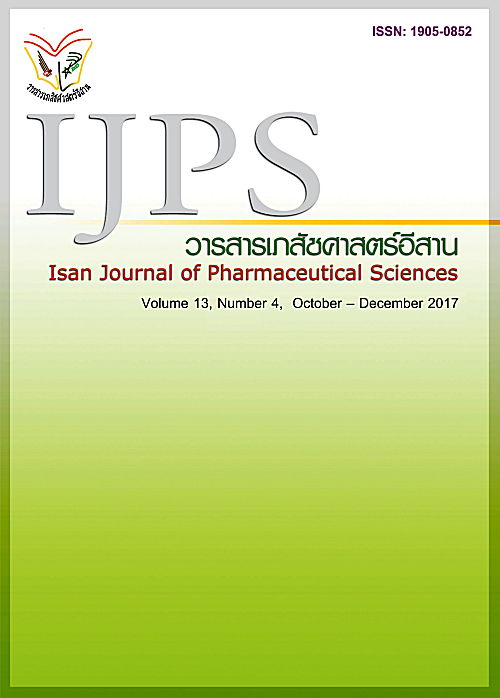Induction of Colitis in Experimental Animals : A Review
Main Article Content
Abstract
Inflammatory bowel disease (IBD) is a complex multifactorial disease that involves all or part of digestive tract consists of two forms; Crohn’s disease (CD) and ulcerative colitis (UC). However, the etiology of the disease remains elusive and unclear. Hence, an experimental animal model becomes to be recognized as a valuable method and indispensable tool to provide a wide range of options for investigating the mechanism and disease pathophysiology and also facilitate the study on preclinical design to target specific components. The objective of this review is to summarize models for induction of colitis in experimental animals. These models are categorized by the principles and causes of colitis induction, in which these are divided into 4 categories, i.e., chemical induced colitis model, bacterial induced colitis model, adoptive cell transferred colitis model, and transgenic or gene-knockout colitis model. Thus, the optimal model is individual consideration depended on the aim of the study to obtain the informative and applicable data.
Article Details
In the case that some parts are used by others The author must Confirm that obtaining permission to use some of the original authors. And must attach evidence That the permission has been included
References
Barthel M, Hapfelmeier S, Quintanilla-Martínez L, et al. Pretreatment of mice with streptomycin provides a Salmonella enterica serovar Typhimurium colitis model that allows analysis of both pathogen and host. Infect Immun 2003; 71(5): 2839-2858.
Boirivant M, Fuss IJ, Chu A, Strober W. Oxazolone colitis: a murine model of T helper cell type 2 colitis treatable with antibodies to interleukin 4. J Exp Med 1998; 188(10): 1929-1939.
Bregenholt S, Petersen TR, Claesson MH. The majority of lamina propria CD4+ T-cells from scid mice with colitis undergo Fas-mediated apoptosis in vivo. Immunol Lett 2001; 78(1): 7-12.
Elson CO, Sartor RB, Tennyson GS, Riddell RH. Experimental models of inflammatory bowel disease. Gastroenterol 1995; 109(4): 1344-1367.
Ghia JE, Blennerhassett P, El-Sharkawy RT, Collins SM. The protective effect of the vagus nerve in a murine model of chronic relapsing colitis. Am J Physiol Gastrointest Liver Physiol 2007; 293(4): 711-718.
Head KA, Jurenka JS. Inflammatory bowel disease part I: ulcerative colitis-pathophysiology and conventional and alternative treatment options. Altern Med Rev 2003; 8(3): 247-283.
Kanneganti M, Mino-Kenudson M, Mizoguchi E. Animal models of colitis-associated carcinogenesis. J Biomed Biotechnol 2011; 1-23.
Kaplan GG, Ng SC. Understanding and preventing the global increase of inflammatory bowel disease. Gastroenterol 2017; 152(2): 313-321.
Kiesler P, Fuss IJ, Strober W. Experimental models of inflammatory bowel diseases. Cell Mol Gastroenterol Hepatol 2015; 1(2): 154-170.
Kitajima S, Takuma S, Morimoto M. Histological analysis of murine colitis induced by dextran sulfate sodium of different molecular weights. Exp Anim 2000; 49(1): 9-15.
Loftus CG, Loftus EV, Harmsen WS, et al. Update on the incidence and prevalence of Crohn's disease and ulcerative colitis in Olmsted County, Minnesota, 1940–2000. Inflamm Bowel Dis 2007; 13(3): 254-261.
Low D, Nguyen DD, Mizoguchi E. Animal models of ulcerative colitis and their application in drug research. Drug Des De Ther 2013; 7: 1341–1357.
MacPherson BR, Pfeiffer CJ. Experimental production of diffuse colitis in rats. Digestion 1978; 17(2):135-150.
Morrissey PJ, Charrier K, Braddy S, Liggitt D, Watson JD. CD4+ T cells that express high levels of CD45RB induce wasting disease when transferred into congenic severe combined immunodeficient mice. Disease development is prevented by cotransfer of purified CD4+ T cells. J Exp Med 1993; 178(1): 237-244.
Neurath M, Fuss I, Strober W. TNBS-colitis. Int Rev Immunol 2000; 19(1): 51-62.
Perše M, Cerar A. Dextran sodium sulphate colitis mouse model: traps and tricks. J Biomed Biotechnol 2012; 1-13.
Sadlack B, Merz H, Schorle H, Schimpl A, Feller AC, Horak I. Ulcerative colitis-like disease in mice with a disrupted interleukin-2 gene. Cell 1993; 75(2): 253-261.
Scheiffele F, Fuss IJ. Induction of TNBS colitis in mice. In: Coligan JE, Kruisbek AM, Margulies DH, Shevach EM, Strober W, editors. Current Protocols in Immunology. New York (NY): John Wiley & Sons; 2007. 15.
Schorle H, Hunig T. Development and function of T cells in mice rendered interleukin-2 deficient by gene targeting. Nature 1991; 352(6336): 621-624.
Uehira M, Matsuda H, Hikita I, Sakata T, Fujiwara H, Nishimoto H. The development of dermatitis infiltrated by γδ T cells in IL-7 transgenic mice. Int Immunol 1993; 5(12): 1619-1627.
Watanabe M, Ueno Y, Yajima T, et al. Interleukin 7 transgenic mice develop chronic colitis with decreased interleukin 7 protein accumulation in the colonic mucosa. J Exp Med 1998; 187(3): 389-402.
Wirtz S, Neufert C, Weigmann B, Neurath MF. Chemically induced mouse models of intestinal inflammation. Nat Protoc 2007; 2(3): 541-546.
Yamada T, Marshall S, Specian RD, Grisham MB. A comparative analysis of two models of colitis in rats. Gastroenterology 1991; 102(5): 1524-1534.


